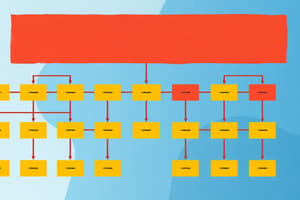Podcast
Questions and Answers
Which action reflects 'problem dissolving' in strategic-action planning?
Which action reflects 'problem dissolving' in strategic-action planning?
- Discarding the initial problem definition and restarting the entire problem-solving process. (correct)
- Abandoning the current solution and seeking a better one within the same problem set.
- Refining the existing solution by reducing errors through reanalysis.
- Implementing the selected solution while closely monitoring its effects.
What characteristic of public problems is highlighted by the influence of varied opinions and values on proposed solutions?
What characteristic of public problems is highlighted by the influence of varied opinions and values on proposed solutions?
- Instability
- Complexity
- Subjectivity (correct)
- Interdependency
Which scenario demonstrates the 'instability' characteristic of public problems?
Which scenario demonstrates the 'instability' characteristic of public problems?
- A policy designed to reduce unemployment leads to an unexpected increase in inflation.
- An environmental regulation is challenged in court due to conflicting scientific evidence.
- A government agency struggles to implement a new program due to budget constraints.
- A community's perception of a traffic congestion issue changes after a new public transportation system is introduced. (correct)
What is the primary focus of 'problem resolving' within the context of strategic planning?
What is the primary focus of 'problem resolving' within the context of strategic planning?
In what context would a 'functional issue' most likely arise within a governmental organization?
In what context would a 'functional issue' most likely arise within a governmental organization?
What distinguishes strategic policies from operational policies?
What distinguishes strategic policies from operational policies?
When is it most appropriate to employ 'problem unsolving' in a strategic-action planning process?
When is it most appropriate to employ 'problem unsolving' in a strategic-action planning process?
Which level of governmental issues would most likely involve decisions about specific projects and personnel staffing?
Which level of governmental issues would most likely involve decisions about specific projects and personnel staffing?
What does the concept of 'interdependency' suggest about problems in public administration?
What does the concept of 'interdependency' suggest about problems in public administration?
In the context of strategic planning, what is the utility of a problem tree analysis?
In the context of strategic planning, what is the utility of a problem tree analysis?
Which of the following scenarios exemplifies the application of 'problem dissolving' in a city planning context?
Which of the following scenarios exemplifies the application of 'problem dissolving' in a city planning context?
A state government implements a new education policy that significantly changes school funding formulas. This decision would be categorized as addressing which type of issue?
A state government implements a new education policy that significantly changes school funding formulas. This decision would be categorized as addressing which type of issue?
A city council votes to construct a new bridge that will irrevocably alter the landscape of the riverfront. This decision is an example of:
A city council votes to construct a new bridge that will irrevocably alter the landscape of the riverfront. This decision is an example of:
In managing a city's resources, adjusting budget allocations in response to unexpected revenue changes represents which type of issue management?
In managing a city's resources, adjusting budget allocations in response to unexpected revenue changes represents which type of issue management?
A local government initially adopts a policy to reduce carbon emissions by promoting electric vehicles but later abandons this policy after realizing it disproportionately benefits wealthier residents. This action BEST exemplifies:
A local government initially adopts a policy to reduce carbon emissions by promoting electric vehicles but later abandons this policy after realizing it disproportionately benefits wealthier residents. This action BEST exemplifies:
A public health crisis reveals that inadequate healthcare access is intertwined with poverty, education, and housing issues. Which characteristic of public problems does this situation illustrate?
A public health crisis reveals that inadequate healthcare access is intertwined with poverty, education, and housing issues. Which characteristic of public problems does this situation illustrate?
A newly elected mayor decides to change the city zoning laws to promote sustainable development, a move that is met with strong opposition from real estate developers and some community groups. This scenario exemplifies which aspect of public problem-solving?
A newly elected mayor decides to change the city zoning laws to promote sustainable development, a move that is met with strong opposition from real estate developers and some community groups. This scenario exemplifies which aspect of public problem-solving?
A city implements a congestion pricing scheme to reduce traffic during peak hours. However, after a few months, it becomes clear that the scheme is pushing traffic to adjacent residential areas, creating new problems. The changes made to the initial plan to address the spillover effects demonstrate:
A city implements a congestion pricing scheme to reduce traffic during peak hours. However, after a few months, it becomes clear that the scheme is pushing traffic to adjacent residential areas, creating new problems. The changes made to the initial plan to address the spillover effects demonstrate:
A government agency adopts a policy aimed at improving cybersecurity across all departments. After a year, they realize that the policy is ineffective because it does not address the specific technological needs of each department. They then decide to abandon the initial policy and create customized strategies for each department. This decision BEST exemplifies:
A government agency adopts a policy aimed at improving cybersecurity across all departments. After a year, they realize that the policy is ineffective because it does not address the specific technological needs of each department. They then decide to abandon the initial policy and create customized strategies for each department. This decision BEST exemplifies:
What analytical tool is designed to visually represent the cause-and-effect relationships of a problem to facilitate the development of effective solutions?
What analytical tool is designed to visually represent the cause-and-effect relationships of a problem to facilitate the development of effective solutions?
Flashcards
Interdependency
Interdependency
Problems are linked and don't exist in isolation.
Subjectivity in Problem Solving
Subjectivity in Problem Solving
Problem definitions and solutions are influenced by opinions, politics, and values.
Instability in Problem Solving
Instability in Problem Solving
Problem definitions and effective solutions can change over time.
Problem Resolving
Problem Resolving
Signup and view all the flashcards
Problem Dissolving
Problem Dissolving
Signup and view all the flashcards
Problem Unsolving
Problem Unsolving
Signup and view all the flashcards
Major Issues
Major Issues
Signup and view all the flashcards
Secondary Issues
Secondary Issues
Signup and view all the flashcards
Functional Issues
Functional Issues
Signup and view all the flashcards
Minor Issues
Minor Issues
Signup and view all the flashcards
Strategic Policies
Strategic Policies
Signup and view all the flashcards
Operational Policies
Operational Policies
Signup and view all the flashcards
Problem Tree Analysis
Problem Tree Analysis
Signup and view all the flashcards
Study Notes
- Interdependency means that most problems are connected to other problems.
- Subjectivity suggests some problems can be affected by political constructions.
- Finding solutions is subjective, as opinions, politics, and values can shape the course of action.
- Instability indicates that the definition of a problem, and its perceived solutions, can evolve over time.
- Problem resolving involves reanalyzing a correctly structured problem to reduce errors.
- Problem dissolving involves discarding an incorrectly understood problem, then restructuring it from scratch to start with a new approach.
- Problem unsolving is the abandonment of a solution, rethinking the problem, to come up with a better solution.
- Major issues typically concern the highest levels of government.
- Secondary issues relate to agency programs at the federal, state, and local levels.
- Functional issues involve budget, finance, procurement, program, and project levels.
- Minor issues pertain to specific projects, such as personnel and staffing.
- Strategic policies involve irreversible consequences.
- Operational policies involve reversible consequences.
- Problem tree analysis, also known as situational analysis, helps identify solutions by mapping out cause and effect. It resembles a mind map but with more structure.
Studying That Suits You
Use AI to generate personalized quizzes and flashcards to suit your learning preferences.




